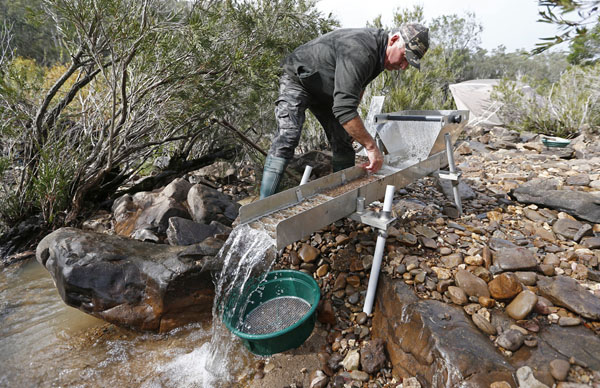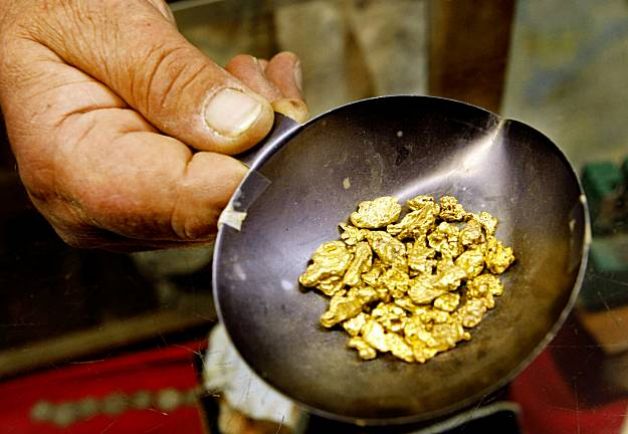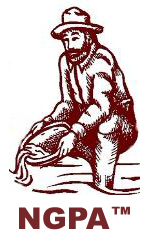Glory Hole: the Gold Prospector’s Dream Come True

A glory hole is a gold prospector’s dream come true, a find of treasures that boggle the mind and excite the spirit.
After twenty years of prospecting for gold in New England, I am used to an average day’s find of a few nice pieces of color and a fraction of an ounce of fine gold. This is a narrative of a glory hole that proved itself on July 21, 1990.
The story began last September at the Wild Ammonoosuc River in Swiftwater, New Hampshire. That day was crisp, cool and breezy; a day where hard work in the mountain waters of this river, which drains the western side of the White Mountains National Forest, helps to keep a body warm.

After a couple of hours of working the banks of the river, an area was discovered well into the woods that has a layer of clay close to the surface, about eight inches down. The clay here is usually rock-hard, and gold tends to find its way down to bedrock and hardpan. Gold will not work its way through a layer of clay. An area of about ten square feet was carefully cleaned off of the clay and run through a home-made sluice. The result was a vial of fine gold and a few nuggets in the one-eighth inch range. The total for the afternoon’s work was just less than one quarter troy ounce.
By five-thirty, my wife, Millie, was reminding me that I had promised to quit at four and take her to dinner. I have had a few heart attacks so she worries, a bit too much. Reluctantly, my mess at the river bank was cleaned up and this good hole was left behind. But with all that gold, by New England standards, I promised myself, and Millie, that I would be back before the season was over.
On October 11, 1989, I had another heart attack, a mild one, but enough to keep me out of the rivers. Then the winter set in with a vengeance and the season was over till next April or May. It is not uncommon for five feet of snow pack to build up in the White Mountains over the winter. It is the melting of this snow during the spring thaw that swells the rivers of northern New England and moves the gold into and down the rivers.
Finally, July fifth, Millie and I are ready to drive from our weekender’s cabin in Stoddard, New Hampshire, to the Wild Ammonoosuc river, about a two hour drive north. The day dawned with a hazy red sky. There had been a mild thunder storm during the night, along with some rain. By six a.m. we were on our way. As we went farther north on Route I-91, the skies became darker and we drove through another mild storm with a short, but heavy, rain. We left I-91 at Exit 17, Wells River, Vermont, and followed Route 302 east over the Connecticut River into Woodsville, New Hampshire. The Connecticut river was high; higher than I wanted to see it. Following Route 302 along the Ammonoosuc River to Route 112, we saw that this river was really swollen. From Exit 17 to Route 112 is only a fifteen minute drive, so we continued on, knowing that the Wild Ammonoosuc River was also swollen and panning would be impossible.
At the intersection of Routes 302 and 112, the Wild Ammonoosuc joins the Ammonoosuc River. There was no way that anyone was prospecting here today, or for a few days. I drove to the area across from last year’s clay bank and climbed down to the river. It was well into the trees and covering my spot with three feet of rushing, swirling water. The level in midstream, usually knee deep in July, was five feet deep and roaring at about twenty-five miles per hour. Gold was moving in the river for sure.
Fishermen along the river were trying, unsuccessfully, to catch the trout that are so plentiful here. The river was moving so deep and fast that their lines were being swept past them and back to the river bank before the bait could get down through the muddy water. The water was boiling brown in color with no underwater visibility. Panning for gold in dirty water is no more productive than fishing in it. We gave up and got back in the Jeep.

About three miles up river is a country general store called the Swiftwater Stage Stop, operated by Gordon White and his family. Gordon and the locals, enjoying coffee there, told us that about four hours ago two severe thunder storms had come down the valley and dropped three and a half inches of rain in two hours. The sky had lit up with successive strikes of lightning and the noise of thunder and wind had been continuous. The river, they said, would crest by evening and it would be accessible to prospectors again in a few days.
We took out the maps and log books to decide what to do next. I keep log books of every locality I visit or even hear about. This library of loose leaf books often saves the day. A friend had given me a lead on a stream in Vermont, many miles to the southwest. Distances in New England are on a different scale than in the West. Localities for prospecting are only a valley away because every major valley has a river in it.
After about two hours driving, we arrived at the Tweed River in Pittsfield, Vermont. The water level was normal for July in New England. I had been warned that the river had a lot of magnetite, but was not prepared for what was found. Two pails of gravel had enough magnetite to clog up the sluice! Panning out this paydirt was hard work (it was heavy!). The result of the first sluicing was a small amount of fine gold and an eighth-inch nugget. Nearby is the White River, one of Vermont’s better known gold streams. This is the upper part of the river which is a major contributory to the Connecticut River. In Stockbridge, north-east of Pittsfield, it is fast moving and rocky; good gold prospecting country. Gold is reported in the White River anywhere north of the Route 100 bridge a t Stockbridge. We had an interesting day, but my hole at the Wild Ammonoosuc was still calling me.
Two weeks later, with my sister Alice and her husband Paul, Millie and I again headed north from Stoddard, New Hampshire. The day was warm and a bit muggy, but clear with cotton-ball clouds. As we reached Exit 17, the brooks and rivers were all flowing normally. At the spot that had been reluctantly abandoned ten months ago, the Wild Ammonoosuc was flowing normally for a wet July. A friend, Glenn Beebe, met us at the parking area along Route 112. Paul and Glenn portaged the equipment across the river before I even got down to the water. They did not want me lifting because of my heart condition, and anyway, they were excited to get started.
Both Paul and Glenn were on their first prospecting trip. Both men were looking at me, now that all the gear was piled up on the shore, with a questioning “Now what?” The water was flowing at a good clip, with a drop of several inches over a ledge just down stream from us. The first thing that we did was set up the two sluices. I use a 36-inch Gold King, 9 inches wide. The second sluice is one I made several years ago out of sheet metal and angle iron with an expanded metal screen and riffles of aluminum. It is heavy, but works well. The sluices were set up within a few feet of each other so that I could supervise their use without running all over the river. To develop plenty of water action in them we built rock walls to channel the water through the sluices.
Once set up, the next question asked was, “Where is the gold?” “Where you find it,” I replied. Paul did not think that was as funny as I did.
Anyway, I showed them the spot where last year’s gold was found and how to get at the clay bank. The clay here is a gray, smooth, and usually hard, layer several inches down in the gravel. We were about twenty feet from the water, and about two vertical feet above it. I suggested that Paul work an area about twenty feet from the water, just downstream from a rock covered with dense bushes. Glenn was put upstream behind a felled tree, and a bit closer to the water. I selected a less accessible spot ten feet down river from a twelve foot high boulder that jutted at an angle well into the river. I dug down about eighteen inches with no sign of clay. All the gravel was run through a coarse Keene screen and then the sluice. The screen got rid of the flat, hand-sized rocks that screw up the water action in the sluice. Nothing big enough to show up right away appeared.
Paul hit clay first and ran his gravel through the hand made sluice. He did not need the concentrator. Glenn, meanwhile, had hit a layer of clay also, but had not scraped it clean. He used finer concentrators to get the paydirt to a level that he could use a pan. The pan he brought was a new, shiny steel pan. I explained that it needed to be cured and rusted up before it would work well. I loaned him a green plastic pan.
Now it was time to clean off Paul’s sluice carpeting. I showed him how to open the sluice, clean the carpet, and start working down the concentrates. I left him alone to help Glenn.
After several minutes, Paul let out a shout–“GOLD!” He saw a quarter-inch nugget in the pan and let us all know about it. The wives, across the river suddenly became interested. I pulled a vial out of my backpack and handed Paul the tweezers. The pan produced several smaller nuggets and flakes. Not bad for his first pan!
I then went back to my hole, while Glenn used the sluice. At two feet down, I hit the clay bank. The clay had a consistency and color of wet cement, soft and flexible to the touch. An area about the size of a three foot circle was cleared above the clay. Most of it was run through the sluice, but the two inches just above the clay was put into a separate bucket for hand panning. This two inches of paydirt is what I was after. I emptied the sluice into a bucket and put the bucket aside so that Glenn or Paul could use the sluice. The gravel that came off of the clay was washed and the clay was dissolved to free any gold. It was surprisingly easy to dissolve the soft clay which had almost no rocks trapped in it. This was run through a half inch plastic screen, then a quarter inch
metal screen.
GOLD!
Sitting on the quarter inch screen was the biggest nugget I have ever collected. I let out a shout that startled Millie from across the river, and Glenn who was standing nearby. Millie must have thought I was having another heart attack. She may have been right! My heart did miss a few beats and produce a few thumps! Paul and Glenn came rushing over. We all had opinions on how many ounces it weighed. I had visions of a record that would beat the 1.1 ounce nugget found in 1985 by Alexander Sweet, a local prospector. Back home the scale said that the nugget was 0.547 troy ounces. My biggest by a factor of ten, but no record. It was a half hour before I got back to the rest of the bucket of concentrate. It contained several nuggets ranging to a quarter inch and a lot of fine gold. After a break for lunch, my sister, Alice, joined her husband and the two of them sat with tweezers picking out the gold from several pans of concentrates. A lot of it turned out to be mica. There was little fine gold in the bottle when it was cleaned
up days later. It takes practice to get all of the fine gold and flour gold out of a pan. The nuggets are easy to get.
Because the clay bank is up in the woods, it probably had never been disturbed. By the end of the day, all of us had several small nuggets to show for our labor. By New England standards, several quarter inch nuggets in one day is exceptional, and only one or two large nuggets over a half ounce are reported annually in the Wild Ammonoosuc River.
This clay bank in the woods is the Glory Hole. There was more gold pulled out of here in the two visits so far than I have collected in my twenty years of experience.

